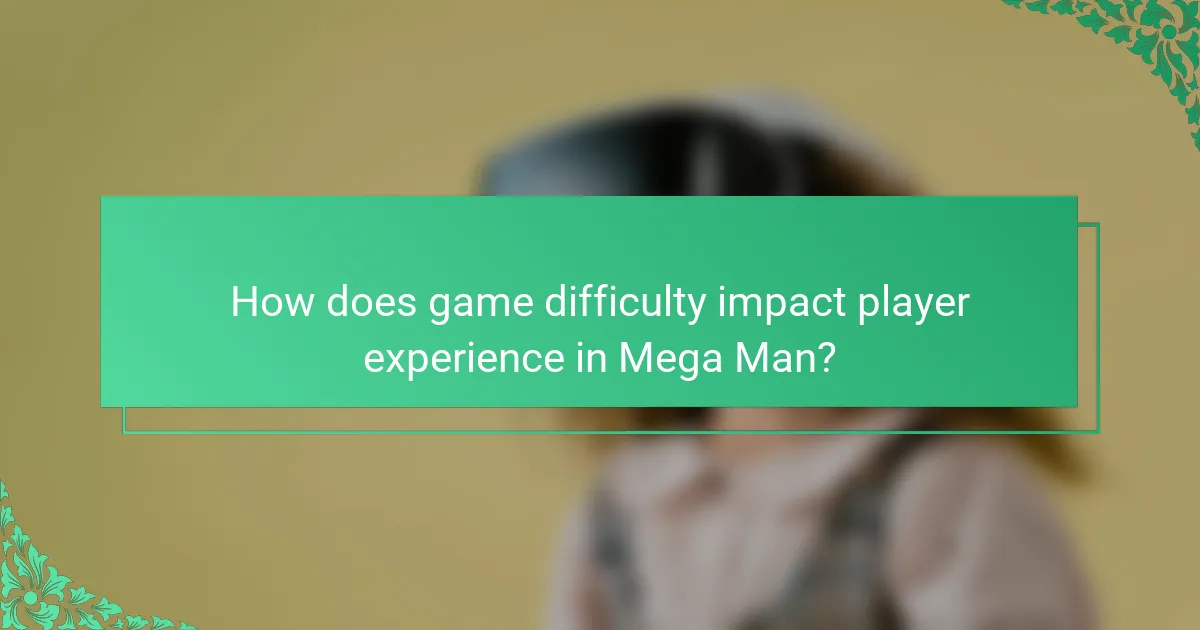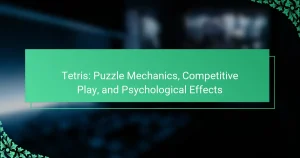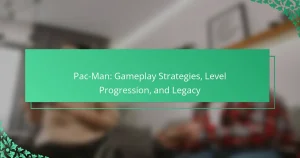Mega Man offers a unique blend of character abilities, challenging game difficulty, and significant influence on the platformer genre. Players engage with dynamic combat mechanics, including the ability to absorb powers from defeated bosses. The game’s design balances difficulty to enhance player satisfaction and replayability. Additionally, Mega Man’s impact on level design and gameplay expectations has shaped countless titles in the platforming landscape.

What character abilities define Mega Man’s gameplay?
Mega Man’s gameplay is defined by abilities like shooting, jumping, and utilizing special weapons. These abilities create a dynamic combat system that emphasizes precision and strategy. The character’s iconic ability to absorb defeated bosses’ powers adds depth and variety, enhancing gameplay experiences. Additionally, Mega Man’s movement mechanics influence platforming elements, establishing benchmarks for difficulty and design in the genre.
How do special weapons enhance Mega Man’s combat strategy?
Special weapons significantly enhance Mega Man’s combat strategy by providing unique abilities tailored to specific enemies and challenges. Each weapon acquired from defeated bosses offers distinct advantages, allowing players to exploit enemy weaknesses effectively. This versatility encourages adaptive gameplay, as players can choose the optimal weapon based on the situation. Additionally, the strategic use of special weapons can simplify difficult encounters, reducing overall game difficulty. By integrating these tools, Mega Man’s combat becomes more dynamic and engaging, influencing the design of future platformers.
What are the unique abilities gained from defeated bosses?
Defeated bosses in Mega Man grant unique abilities that enhance gameplay. Each ability corresponds to a specific boss and introduces new mechanics, enriching the player’s arsenal. For example, defeating Cut Man allows the player to use the Rolling Cutter, a weapon that can slice through enemies and obstacles. Other abilities, like Ice Slasher from Ice Man, enable players to freeze enemies or create platforms. These unique abilities not only diversify combat strategies but also influence level navigation and puzzle-solving. Overall, the incorporation of these abilities adds depth and replayability to the game.
How do Mega Man’s abilities compare to other platformer characters?
Mega Man’s abilities are distinct and versatile, often surpassing those of other platformer characters. His signature power is the ability to acquire abilities from defeated bosses, allowing for strategic gameplay. In contrast, many platformer characters have fixed abilities, limiting their adaptability. Mega Man’s level of difficulty varies, often presenting challenging gameplay that requires skill and precision. This complexity influences the design of many platformers, inspiring characters with unique abilities and diverse gameplay mechanics. Overall, Mega Man’s unique attribute of ability acquisition sets him apart in the platforming genre.

How does game difficulty impact player experience in Mega Man?
Game difficulty significantly impacts player experience in Mega Man by influencing engagement and satisfaction levels. Higher difficulty promotes challenge, encouraging players to develop skills and strategies. Conversely, lower difficulty can lead to frustration or boredom. The game’s design balances these elements, creating a unique experience tailored to diverse player preferences. For instance, the ability to choose difficulty settings allows players to customize their experience, enhancing enjoyment and replayability.
What factors contribute to the challenge level in Mega Man games?
The challenge level in Mega Man games is influenced by enemy design, level complexity, and player mechanics. Enemy patterns require precise timing and strategy. Levels often feature intricate layouts with traps and obstacles. Player abilities, such as weapon choice and power-ups, affect difficulty. Each game introduces unique mechanics that can alter challenge perceptions.
How do difficulty settings vary across different Mega Man titles?
Difficulty settings in Mega Man titles vary significantly, affecting gameplay experience. Early games typically featured a fixed difficulty, while later entries introduced adjustable settings. For example, Mega Man 9 allowed players to select from easy, normal, and hard modes, enhancing accessibility. Additionally, Mega Man X series introduced elements like health upgrades and special abilities that influenced difficulty. The unique attribute of each title’s design philosophy shapes player engagement, making difficulty a key aspect of Mega Man’s legacy in platformers.
What strategies can players use to overcome challenging levels?
Players can overcome challenging levels in Mega Man by mastering character abilities, utilizing strategic power-ups, and practicing level layouts. Focus on timing and precision to navigate obstacles effectively.
Experiment with different character abilities to find the best match for each level’s challenges. For example, using specific powers can exploit enemy weaknesses and simplify difficult sections.
Practice makes perfect; replaying levels helps players familiarize themselves with enemy patterns and traps. Additionally, learning the unique attributes of each character can provide advantages in tough situations.
Finally, consider collaborating with other players to share strategies and insights, enhancing overall gameplay experience.

In what ways has Mega Man influenced the platformer genre?
Mega Man has significantly influenced the platformer genre through its unique character abilities, challenging game difficulty, and innovative level design. The series introduced the concept of acquiring abilities from defeated bosses, enhancing gameplay variety. This mechanic has been adopted in many platformers, allowing players to customize their approach. Additionally, Mega Man’s difficulty level set a benchmark, encouraging other games to create challenging yet fair experiences. The game’s emphasis on precise controls and timing has shaped the expectations for platformer mechanics, inspiring numerous titles in the genre.
Which gameplay mechanics from Mega Man have been adopted by other games?
Many gameplay mechanics from Mega Man have influenced other games, particularly in the platforming genre. Notable examples include the ability to acquire enemy skills, the use of power-ups, and challenging difficulty levels.
Several games have adopted the iconic “boss fight” structure, where players defeat unique enemies to gain new abilities. This mechanic enhances gameplay variety and encourages exploration.
The concept of weapon energy management, where players must strategically use acquired abilities, has been seen in titles like Shovel Knight and Hollow Knight.
Additionally, Mega Man’s level design, which often features branching paths and secrets, has inspired numerous platformers, promoting replayability and player engagement.
How has Mega Man’s design inspired character creation in modern platformers?
Mega Man’s design has significantly influenced modern platformers by popularizing character abilities and game difficulty mechanics. His unique ability to acquire skills from defeated bosses has inspired many games to incorporate similar mechanics, enhancing gameplay variety. Additionally, Mega Man’s distinct visual style and character design have set a standard for character aesthetics in the genre. As a result, many developers strive to create characters with memorable designs and engaging abilities, reflecting Mega Man’s lasting impact on platformer development.
What role does nostalgia play in Mega Man’s enduring legacy?
Nostalgia plays a significant role in Mega Man’s enduring legacy by evoking fond memories for players. The character’s iconic design and challenging gameplay create a lasting emotional connection. This nostalgia influences new generations, driving interest in remakes and sequels. As a result, Mega Man remains a beloved figure in platform gaming, showcasing the impact of nostalgia on its cultural relevance.

How do cultural perceptions of Mega Man differ across regions?
Cultural perceptions of Mega Man vary significantly across regions due to historical, social, and gaming industry contexts. In Japan, Mega Man is celebrated for its challenging gameplay and innovative mechanics, often viewed as a classic symbol of the platforming genre. In contrast, Western audiences focus more on the character’s design and narrative, sometimes critiquing the game’s difficulty.
The character’s abilities, such as acquiring powers from defeated foes, resonate differently; Japanese players appreciate the strategic depth, while Western players may find it less impactful. Regional marketing strategies also shape perceptions; Japan emphasizes the franchise’s legacy, while Western campaigns often highlight action and adventure elements.
As a result, Mega Man’s influence on platformers is recognized differently, with Japanese titles emphasizing precision and skill, while Western games may prioritize accessibility and storytelling. This divergence illustrates how cultural contexts shape the understanding and appreciation of video game characters and their narratives.
What are the most popular Mega Man titles in various markets?
The most popular Mega Man titles vary by market, showcasing unique preferences. In North America, “Mega Man 2” and “Mega Man X” dominate due to their innovative gameplay and character abilities. Japan favors “Mega Man Battle Network” for its strategic elements, while Europe has a strong following for “Mega Man 3” due to its challenging difficulty. Each title’s influence on platformers is significant, with unique attributes like “Mega Man X’s” dash mechanic enhancing gameplay experiences.
How do local gaming communities engage with Mega Man?
Local gaming communities engage with Mega Man through fan art, speedrunning events, and collaborative game nights. These activities foster a sense of camaraderie among players. The game’s unique abilities, such as absorbing powers from defeated bosses, inspire creative discussions and strategies. Additionally, the challenge presented by Mega Man’s difficulty level encourages players to share tips and techniques, enhancing the overall gaming experience.

What common mistakes do players make when playing Mega Man?
Players commonly make mistakes in Mega Man by underestimating enemy patterns, neglecting power-up usage, and failing to adapt strategies. These errors can lead to unnecessary deaths and frustration. Understanding character abilities and game difficulty is crucial for success. Players often rush into battles without analyzing the best approach, which can hinder progress. Additionally, overlooking the unique attributes of each weapon can result in missed opportunities to exploit enemy weaknesses.
How can players optimize their approach to mastering Mega Man games?
Players can optimize their approach to mastering Mega Man games by focusing on character abilities, understanding game difficulty, and leveraging strategies influenced by platformers. Mastering character abilities is crucial; each character has unique powers that can be used strategically against specific bosses. Understanding the game’s difficulty curve helps players anticipate challenges and adjust their tactics accordingly. Utilizing techniques from other platformers, such as precise jumping and timing, enhances gameplay. Players should practice consistently, learn enemy patterns, and experiment with different character abilities to find the most effective strategies.


